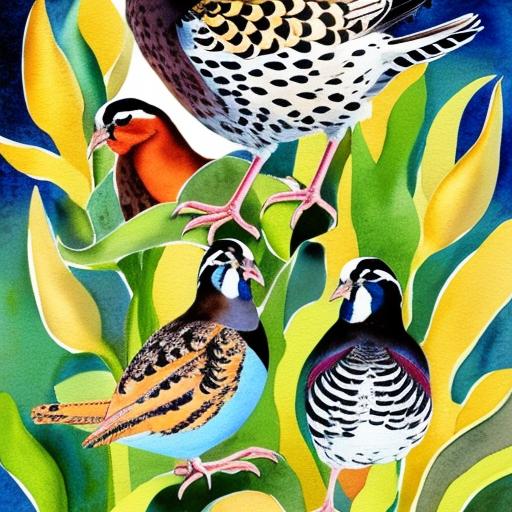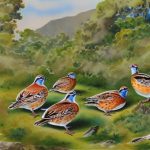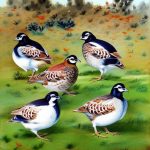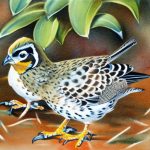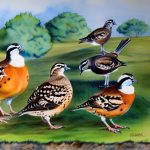Cold hardy quail breeds are a group of quail species that are well adapted to cold climates and can withstand harsh winter conditions. These breeds are sought after by quail enthusiasts who live in regions with cold winters, as they are able to thrive and continue laying eggs even in low temperatures. Some popular cold hardy quail breeds include the Coturnix quail, Bobwhite quail, and Gambel’s quail. These breeds have developed natural adaptations to survive in cold weather, such as thicker plumage, smaller combs, and a higher metabolic rate to generate more body heat. Understanding the specific characteristics and needs of cold hardy quail breeds is essential for successful breeding and raising of these birds.
Cold hardy quail breeds are known for their ability to withstand cold temperatures and continue laying eggs throughout the winter months. They have evolved to survive in colder climates by developing thicker feathers and down to provide insulation, as well as smaller combs and wattles to reduce heat loss. Additionally, these breeds have a higher metabolic rate, which allows them to generate more body heat to stay warm in cold weather. Understanding the unique adaptations of cold hardy quail breeds is crucial for providing them with the proper care and environment to thrive in colder climates. By selecting the right breed for your specific climate and understanding their specific needs, you can ensure the health and productivity of your cold hardy quail flock.
Key Takeaways
- Cold hardy quail breeds are able to withstand low temperatures and harsh weather conditions, making them ideal for colder climates.
- Cold hardy quail breeds are known for their small size, quick maturity, and ability to lay a large number of eggs, making them a popular choice for small-scale poultry farming.
- Breeding and raising cold hardy quail requires providing a suitable environment with proper housing, nutrition, and disease management to ensure their well-being and productivity.
- Housing for cold hardy quail should include protection from predators, adequate space, and proper ventilation to maintain a healthy and comfortable living environment.
- Feeding cold hardy quail a balanced diet that includes high-quality feed, fresh water, and occasional treats will help ensure their overall health and egg production.
Characteristics of Cold Hardy Quail Breeds
Cold hardy quail breeds have several distinct characteristics that make them well-suited for colder climates. One of the most notable characteristics is their thick plumage, which provides insulation and helps them retain body heat in cold weather. Additionally, these breeds have smaller combs and wattles compared to other quail breeds, which helps reduce heat loss and prevents frostbite in extreme temperatures. Cold hardy quail breeds also have a higher metabolic rate, which allows them to generate more body heat to stay warm in cold weather. These unique characteristics make them resilient and adaptable to harsh winter conditions, making them an ideal choice for quail enthusiasts living in colder regions.
In addition to their physical characteristics, cold hardy quail breeds are known for their ability to continue laying eggs throughout the winter months. This is a highly desirable trait for quail farmers and homesteaders who rely on their quail for a consistent supply of eggs year-round. The ability of cold hardy quail breeds to maintain egg production in cold weather is a result of their higher metabolic rate and efficient use of energy to stay warm. By understanding and appreciating the unique characteristics of cold hardy quail breeds, quail enthusiasts can provide them with the proper care and environment to thrive in colder climates.
Breeding and Raising Cold Hardy Quail
Breeding and raising cold hardy quail requires careful consideration of their specific needs and environmental requirements. When breeding cold hardy quail, it is important to select breeding stock that is well adapted to cold climates and exhibits desirable traits such as thick plumage, small combs, and a high metabolic rate. Providing a suitable breeding environment with proper insulation and protection from harsh weather conditions is essential for successful breeding of cold hardy quail. Additionally, ensuring a balanced diet and adequate nutrition for breeding stock will contribute to healthy offspring with strong cold-hardy traits.
Raising cold hardy quail chicks requires attention to their environmental needs from an early age. Providing a warm and draft-free brooder with proper bedding and heat sources is crucial for the survival and development of young quail in colder climates. It is important to monitor the temperature and humidity levels in the brooder to ensure optimal conditions for the chicks’ growth and well-being. As the chicks mature, transitioning them to outdoor housing with adequate protection from the elements is essential for their continued development and adaptation to cold weather. By understanding the specific requirements for breeding and raising cold hardy quail, quail enthusiasts can successfully maintain a healthy and productive flock in colder climates.
Housing and Care for Cold Hardy Quail
Providing suitable housing and care for cold hardy quail is essential for their health and well-being in colder climates. When housing cold hardy quail, it is important to provide adequate insulation and protection from harsh weather conditions. This can be achieved by using well-insulated coops or shelters with proper ventilation to prevent moisture buildup and drafts. Additionally, providing ample bedding such as straw or wood shavings will help keep the birds warm and comfortable during colder months. It is also important to regularly inspect the housing for any signs of damage or wear that could compromise its ability to provide adequate protection from the elements.
Care for cold hardy quail includes monitoring their health and behavior regularly, especially during extreme weather conditions. Providing access to fresh water that is not frozen is crucial for the birds’ hydration and overall well-being. Additionally, ensuring a balanced diet with adequate nutrition will help support the birds’ immune system and ability to withstand cold temperatures. It is also important to provide opportunities for exercise and foraging, even during winter months, to promote physical activity and mental stimulation for the birds. By providing proper housing and care for cold hardy quail, quail enthusiasts can ensure the health and productivity of their flock in colder climates.
Feeding and Nutrition for Cold Hardy Quail
Feeding and nutrition play a crucial role in maintaining the health and productivity of cold hardy quail in colder climates. Providing a balanced diet that meets the birds’ nutritional needs is essential for supporting their immune system and ability to withstand cold temperatures. Cold hardy quail require a diet that is high in protein to support their energy needs during colder months, as well as essential vitamins and minerals for overall health. Supplementing their diet with sources of calcium, such as crushed oyster shells or limestone, will help support strong eggshell formation for laying hens.
During winter months, it is important to provide additional calories in the form of grains or seeds to help the birds maintain body heat and energy levels. Offering high-quality feed that is free from mold or contaminants will help prevent digestive issues and support the birds’ overall health. Additionally, providing access to fresh water at all times is crucial for hydration, especially when natural water sources may be frozen. By understanding the specific feeding and nutritional needs of cold hardy quail, quail enthusiasts can ensure that their flock remains healthy and productive throughout the winter months.
Health and Disease Management for Cold Hardy Quail
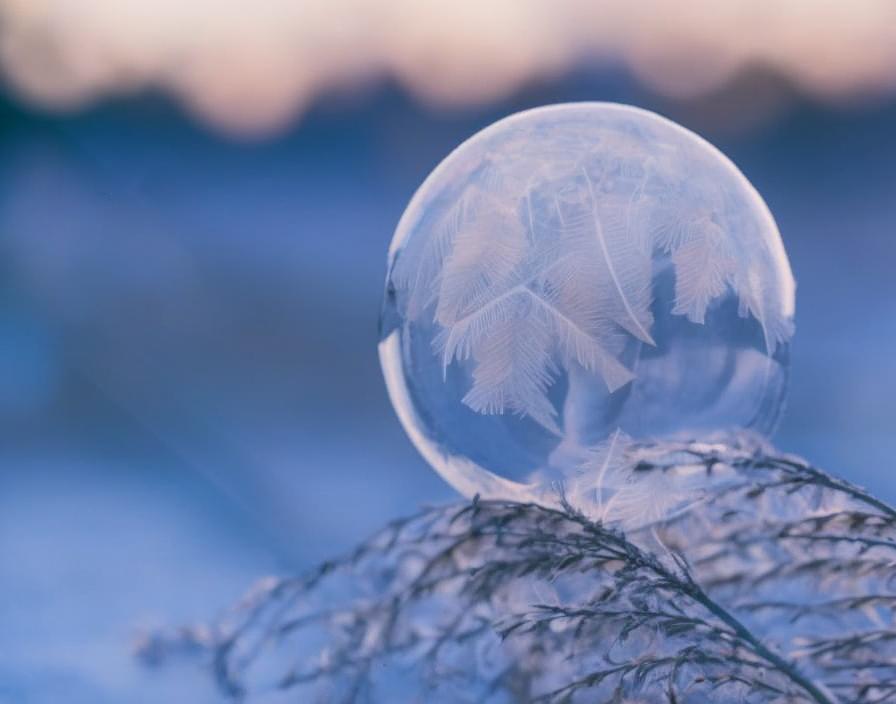
Maintaining the health of cold hardy quail in colder climates requires proactive disease management and regular health monitoring. Cold weather can weaken the immune system of quail, making them more susceptible to diseases and infections. It is important to regularly inspect the birds for any signs of illness or injury, such as lethargy, decreased appetite, or abnormal behavior. Providing a clean and dry environment will help prevent the spread of diseases and parasites among the flock.
In addition to regular health monitoring, it is important to establish a relationship with a veterinarian who specializes in poultry care. A veterinarian can provide guidance on disease prevention strategies, as well as treatment options if illness does occur within the flock. Implementing biosecurity measures, such as quarantining new birds before introducing them to the existing flock, will help prevent the introduction of diseases into the environment. By prioritizing proactive health management and disease prevention strategies, quail enthusiasts can maintain a healthy flock of cold hardy quail in colder climates.
Benefits of Raising Cold Hardy Quail
Raising cold hardy quail offers several benefits for quail enthusiasts living in colder climates. One of the primary benefits is the ability of these breeds to continue laying eggs throughout the winter months, providing a consistent supply of fresh eggs even when other poultry may not be laying. This can be particularly valuable for homesteaders or small-scale farmers who rely on their quail for a source of fresh eggs year-round. Additionally, cold hardy quail are well adapted to withstand harsh winter conditions, making them a resilient choice for poultry enthusiasts living in regions with cold winters.
Another benefit of raising cold hardy quail is their efficient use of feed and resources compared to other poultry species. Quail require less space and feed compared to chickens or ducks, making them a cost-effective option for small-scale poultry production. Their small size also makes them easier to handle and manage, especially in smaller backyard or homestead settings. Furthermore, cold hardy quail are known for their gentle disposition, making them an enjoyable addition to a diverse poultry flock.
In conclusion, understanding the unique characteristics and specific needs of cold hardy quail breeds is essential for successful breeding and raising of these birds in colder climates. By providing suitable housing, proper care, balanced nutrition, proactive health management, and disease prevention strategies, quail enthusiasts can maintain a healthy and productive flock of cold hardy quail throughout the winter months. The benefits of raising cold hardy quail include a consistent supply of fresh eggs, resilience in harsh winter conditions, efficient use of feed and resources, and their gentle disposition as an enjoyable addition to a diverse poultry flock. With proper knowledge and care, raising cold hardy quail can be a rewarding experience for poultry enthusiasts living in colder regions.
If you’re interested in raising cold hardy quail breeds, you might also want to check out Poultry Wizard’s article on turning a shed into a chicken coop. This informative piece provides valuable insights into creating a suitable and comfortable environment for your quail, ensuring they thrive in colder climates. Learn more about turning a shed into a chicken coop here.
FAQs
What are cold hardy quail breeds?
Cold hardy quail breeds are quail species that are able to withstand and thrive in cold temperatures and harsh weather conditions. These breeds are well-suited for colder climates and are able to survive and lay eggs even during the winter months.
What are some examples of cold hardy quail breeds?
Some examples of cold hardy quail breeds include the Coturnix quail, also known as the Japanese quail, and the Bobwhite quail. These breeds are known for their ability to adapt to colder temperatures and are popular choices for quail farming in colder regions.
What characteristics make a quail breed cold hardy?
Cold hardy quail breeds typically have thicker feathers and a higher metabolism, which helps them generate more body heat to stay warm in colder temperatures. They also have a higher tolerance for cold and are able to forage for food even when the ground is covered in snow.
How can I care for cold hardy quail breeds in the winter?
To care for cold hardy quail breeds in the winter, it is important to provide them with a draft-free and insulated coop to protect them from the cold. Additionally, providing extra bedding, supplemental heat sources, and ensuring access to fresh water and high-quality feed can help them thrive during the winter months.
Are cold hardy quail breeds suitable for all climates?
While cold hardy quail breeds are well-suited for colder climates, they may not be the best choice for extremely hot or tropical climates. It is important to consider the specific climate and environmental conditions of your region when choosing the right quail breed for your farm or homestead.
Meet Walter, the feathered-friend fanatic of Florida! Nestled in the sunshine state, Walter struts through life with his feathered companions, clucking his way to happiness. With a coop that’s fancier than a five-star hotel, he’s the Don Juan of the chicken world. When he’s not teaching his hens to do the cha-cha, you’ll find him in a heated debate with his prized rooster, Sir Clucks-a-Lot. Walter’s poultry passion is no yolk; he’s the sunny-side-up guy you never knew you needed in your flock of friends!

